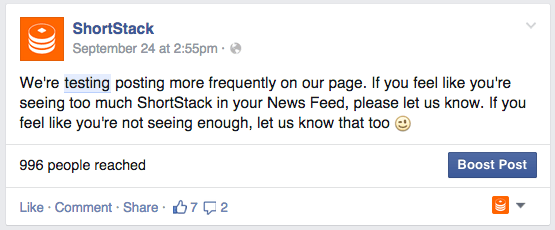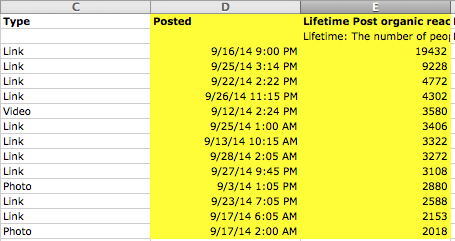If you’re a business on Facebook, there’s a good chance you’ve been fighting the organic reach battle.
In the last year-and-a-half, Facebook organic reach has gone from around 16 percent per post to as little as 1 percent per post. To give you an example of the effect on businesses, my company’s Facebook Page has 74,000 fans. About a month ago, my Facebook manager, Sara, reported to me that we were averaging around 200 reach per post.
There are some companies who give up and delete their pages, but I think that’s a mistake. Facebook is still a huge referral source for my company. It continues to be the top referrer of traffic to my company’s blog and within the top five referrers of traffic to my company’s website. When something isn’t working, I think it’s up to the business to go back to the drawing board and re-strategize.
This is exactly what I did with Sara. We sat down and decided to run some tests and change our posting strategy. The changes we made resulted in a 219 percent increase in our organic reach and a 171 percent increase in engagement in just 30 days.
Our strategy for increasing our reach and engagement was twofold, we were going to narrow down the best times to post for reach and engagement, and take a look at the type of content we were posting and then make adjustments as needed.
Here’s how we made small shifts that resulted in exponential organic growth on our Facebook Page.
We Tested Different Posting Strategies
The battle of post frequency is ongoing. Some people say that too much will drive your audience away and others say that too little may cause that one post to be shown more.
Awhile back, we tested what would happen if we quit Facebook for a week. Needless to say, the test was a small disaster that lowered our overall reach and engagement and it took us weeks to get back to where we were previously.
This time around we decided to do the exact opposite and increase our posting frequency. Before this study we were posting around 3-4 times per day. We were posting mostly during the peak hours that our fans were online. We decided to increase our frequency to every two hours. It was a lot of content and we were worried that our fans might get annoyed so we informed them that we were going to post much more frequently and let them know that we were open to their feedback if they felt they were seeing too much or too little from us.

We decided to increase our posting frequency because we figured if three posts a day reached 200 people, we were reaching 600 people a day. If 12 posts a day reached 200 people, we’d reach 2,400 people a day.
Here’s a look at our posting frequency for the month of September.

The second thing we did was add some variety to the type of posts we were posting. Up until this point we prided ourselves on not being one of those pages that posted silly memes or quotes all day long. We had focused on posting links to our blog articles and educational and valuable articles from other influencers. However, when Sara looked at our analytics she noticed that the occasional funny post or photo did bring in a wave of engagement and reach, so we decided to mix more business related quotes and humorous social media photos into our schedule along with our educational articles.
Our goal was to still keep the posts relevant to social media and business but to alternate between an article and a photo on each status update.
We Studied Our Facebook Insights
After testing our new Facebook strategy for about two weeks, we were ready to look at our Insights and determine which times of day saw the most reach and engagement on our page.
To do this, Sara headed to our Facebook Insights and exported our “Post Data” for our testing period, which was the month of September.
She then looked at our Lifetime Engaged Users and sorted it from the most engaged users to the least engaged. She wrote down the top 12 times that users engaged the most with our posts. You can see the spreadsheet below.

After that, she did the same thing with Lifetime Post organic reach.

After looking at the top times for reach and engagement, we noticed there were quite a few similarities. This makes sense because the more engagement a post gets the better reach it gets. If a few different posts fell into the same hour or hour-and-a-half we combined them. For example, three of the posts with the best reach were posted at the following times, 2:24 pm, 2:22 pm and 3:14 pm, so we categorized all of those into the timeframe of 2:15-3:15 pm.
From our insights we were able to determine that the best times for us to post on our Facebook Page were: 6:00 am, 10:00 am, 12:00-1:00 pm, 2:15-3:15 pm, 9 pm and 2:00 am.
In Conclusion: We Used Our Own Data
Once we’d learned the ideal times to post on our Facebook Page for maximum reach and engagement, it was time to continue testing. We adjusted our posting strategy, again, and made sure to post at these seven key times every day. We also posted 1-2 additional times a day where there were some gaps, like between 3:15 pm and 9 pm and between 9 pm and 2 am. We decided to do this because we have an international audience. Posting throughout the day and night may not be the best practice for every business.
As I write this, it’s been about two weeks since we’ve been posting at our seven key times on Facebook and our reach and engagement continues to go up.
When we compared our reach in the last 30 days to our reach in the 30 days before that, we saw a 219 percent increase. Likewise, we also saw an increase in our engagement by 171 percent.
We also learned that a balanced mix between educational and fun posts keeps our fans engaged and interactive. If posting a great quote brings in 25 likes and 30 shares, those people are more likely to see the next post that your business puts up.
Working with Facebook’s algorithm is an ongoing battle for Facebook page admins. It’s not easy to discover what does and doesn’t work for your Facebook Page, but it is worth it. The key things to focus on are determining what your fans like seeing and interacting with and then focusing on those types of posts at key times determined through your analytics.
Has anyone else out there amended their Facebook tactics in a way that seems to be increasing organic reach? I’m all ears if you have any tips to share with me!
Image Credits
Featured Image via ShortStack
All screenshots taken November 2014


